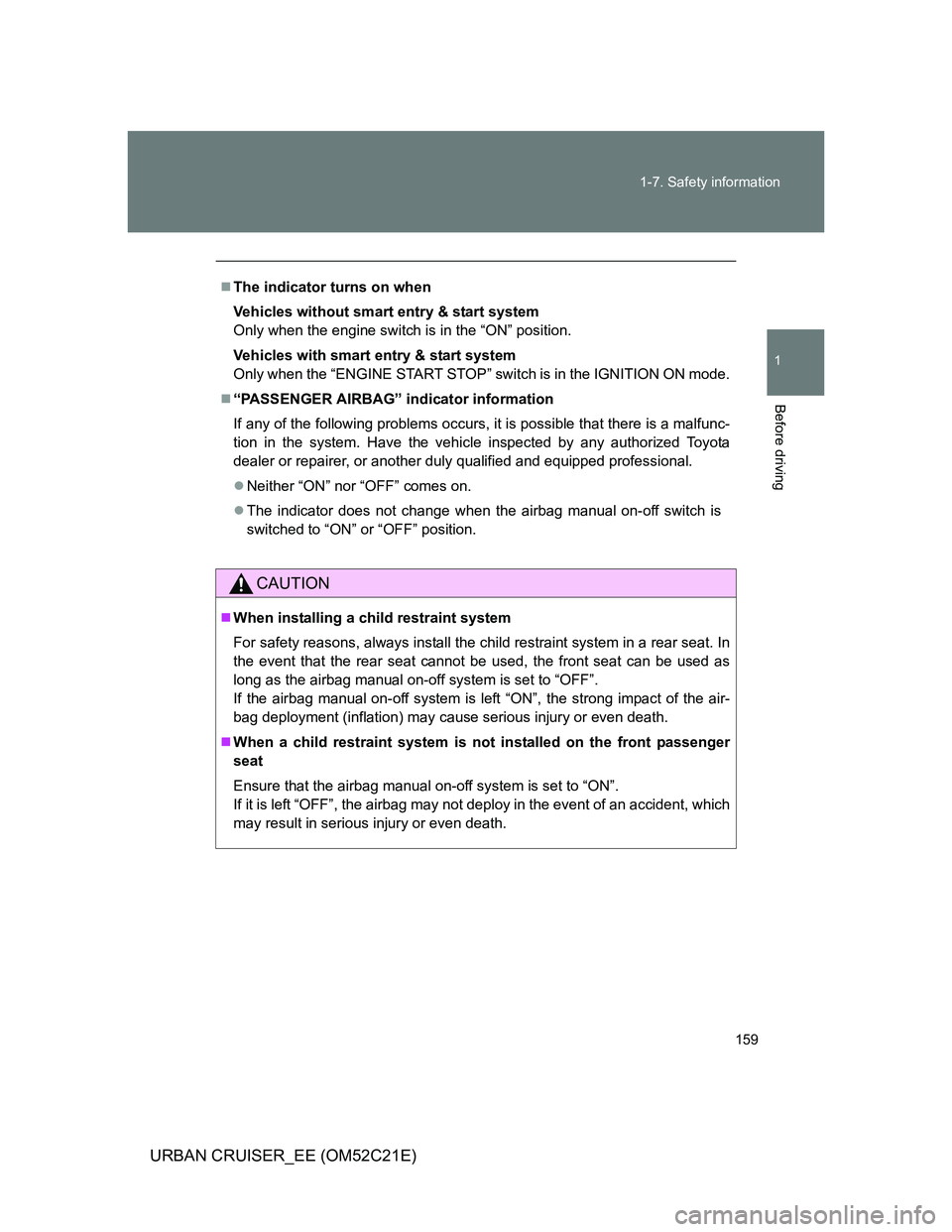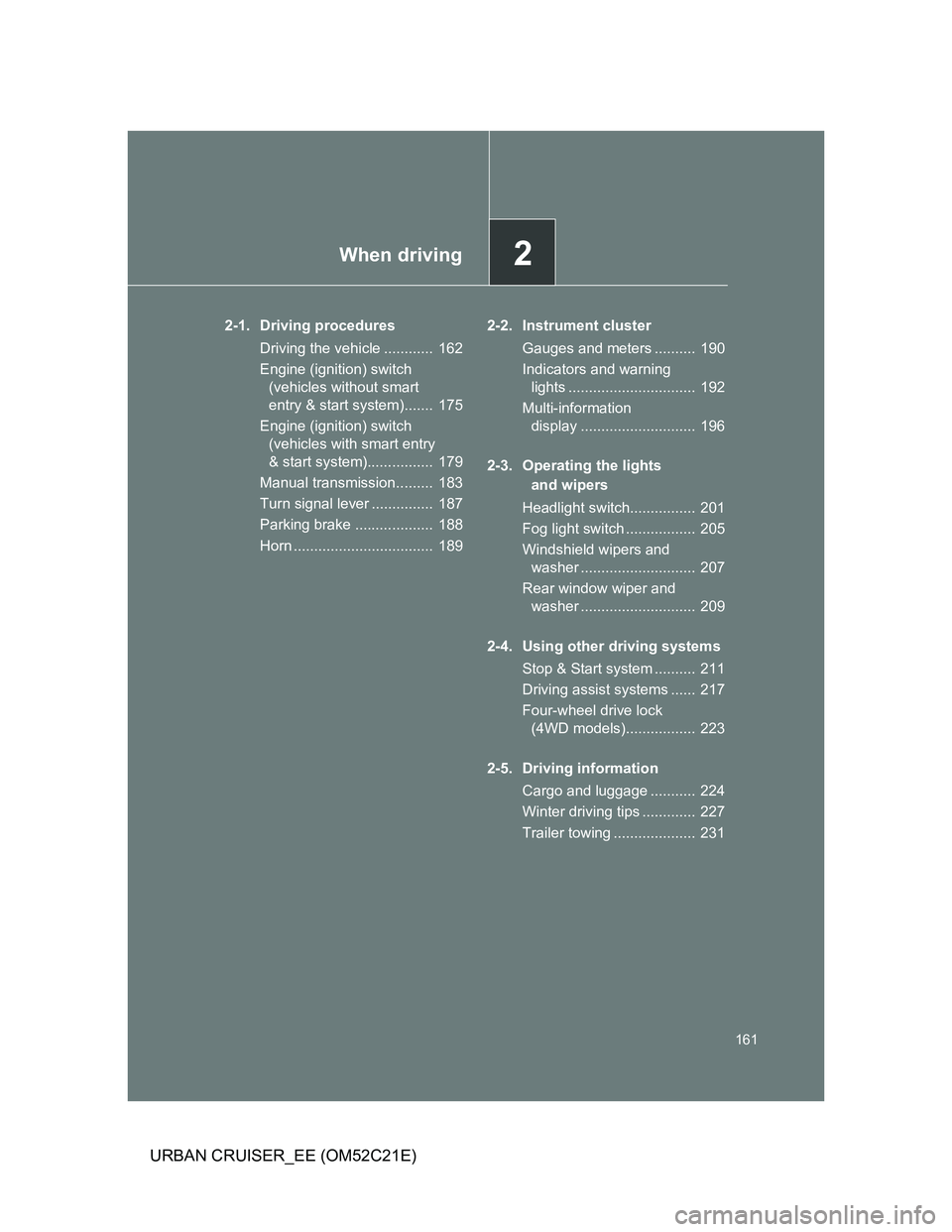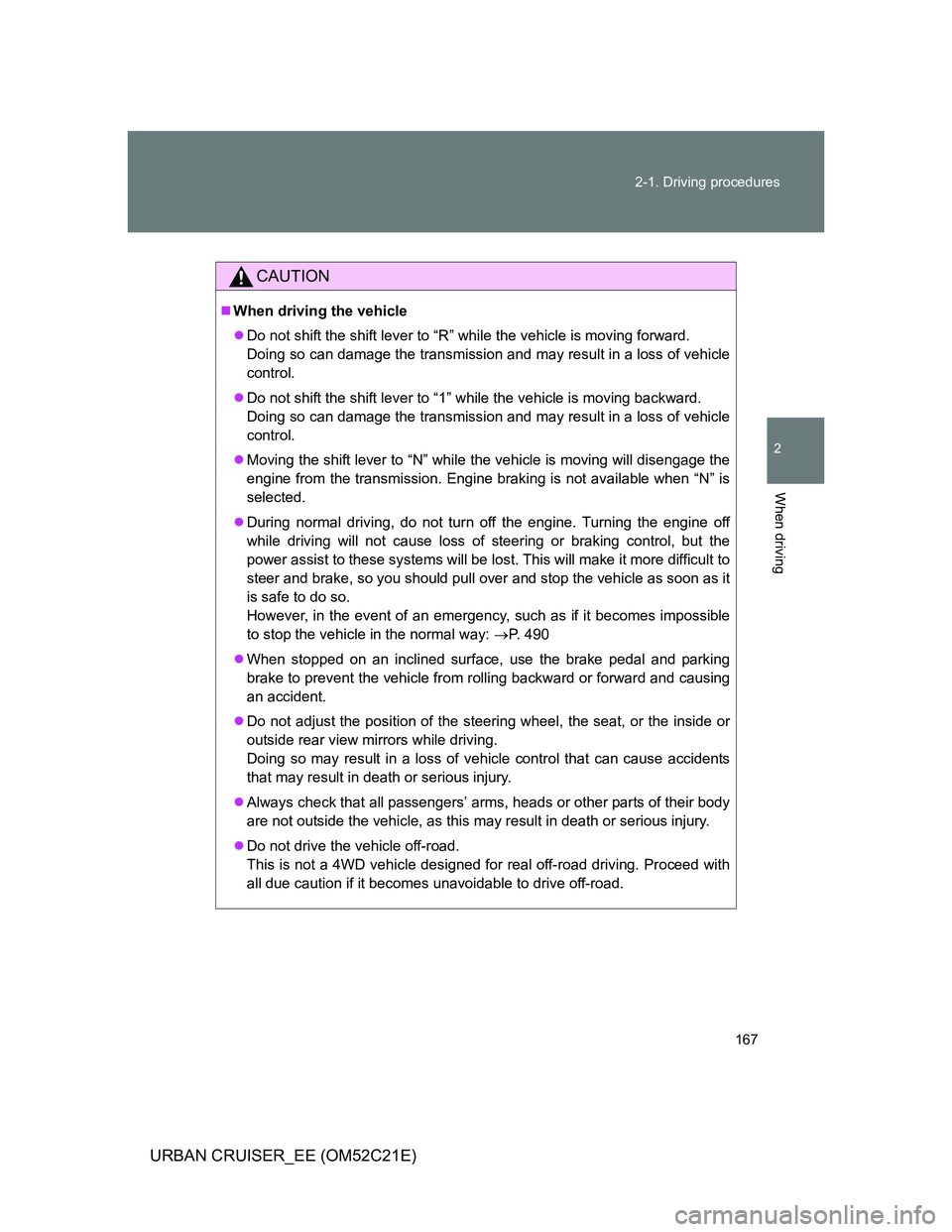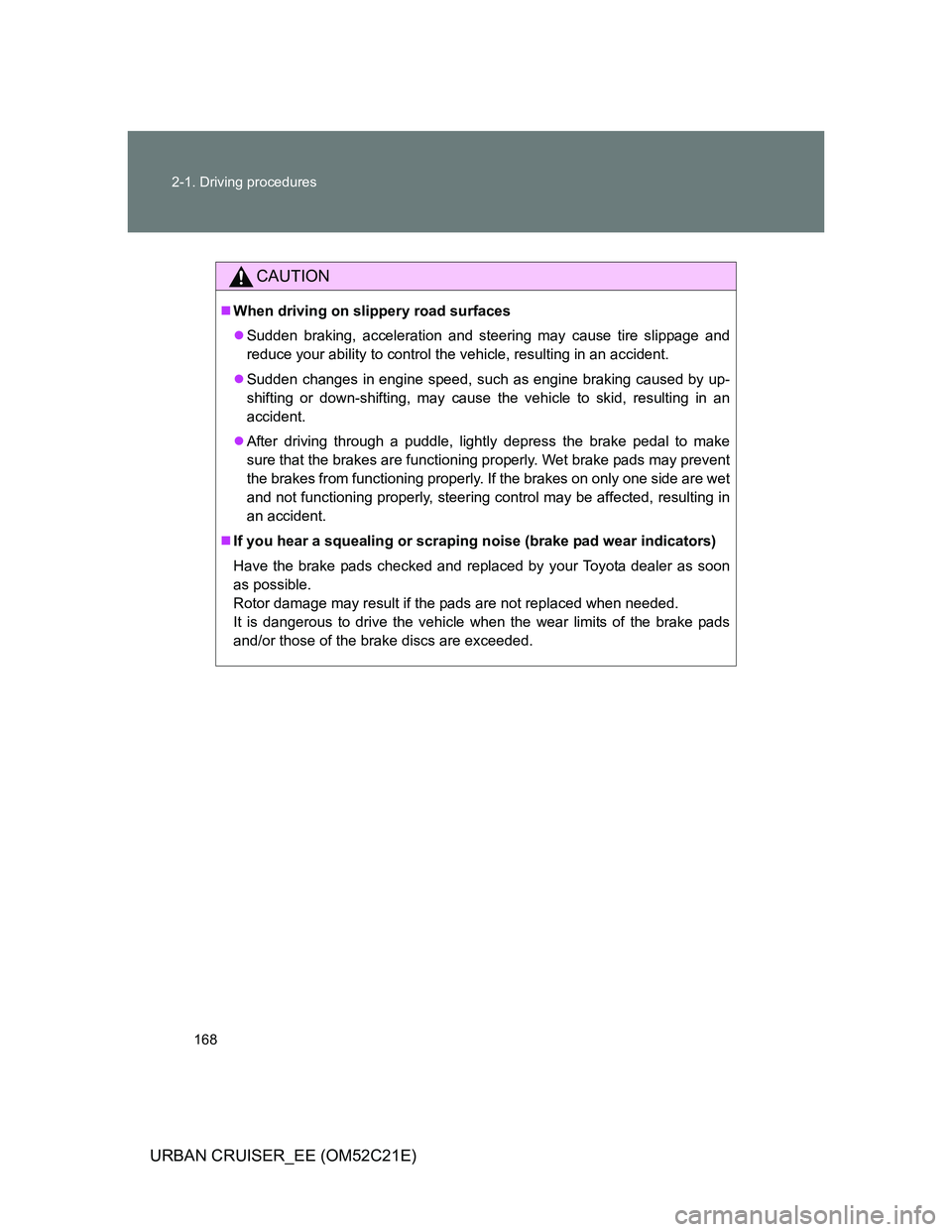Page 119 of 532
119 1-6. Theft deterrent system
1
Before driving
URBAN CRUISER_EE (OM52C21E)
System maintenance
The vehicle has a maintenance-free type alarm system.
Items to check before locking the vehicle
To prevent unexpected triggering of the alarm and vehicle theft, make sure
of the following.
Nobody is in the vehicle.
The windows are closed before the alarm is set.
No valuables or other personal items are left in the vehicle.
Deactivating or stopping the alarm
Do one of the following to deactivate or stop the alarm.
Unlock the doors using the smart entry & start system or the
wireless remote control.
Start the engine. (The alarm will be deactivated or stopped
after a few seconds.)
Page 159 of 532

159 1-7. Safety information
1
Before driving
URBAN CRUISER_EE (OM52C21E)
The indicator turns on when
Vehicles without smart entry & start system
Only when the engine switch is in the “ON” position.
Vehicles with smart entry & start system
Only when the “ENGINE START STOP” switch is in the IGNITION ON mode.
“PASSENGER AIRBAG” indicator information
If any of the following problems occurs, it is possible that there is a malfunc-
tion in the system. Have the vehicle inspected by any authorized Toyota
dealer or repairer, or another duly qualified and equipped professional.
Neither “ON” nor “OFF” comes on.
The indicator does not change when the airbag manual on-off switch is
switched to “ON” or “OFF” position.
CAUTION
When installing a child restraint system
For safety reasons, always install the child restraint system in a rear seat. In
the event that the rear seat cannot be used, the front seat can be used as
long as the airbag manual on-off system is set to “OFF”.
If the airbag manual on-off system is left “ON”, the strong impact of the air-
bag deployment (inflation) may cause serious injury or even death.
When a child restraint system is not installed on the front passenger
seat
Ensure that the airbag manual on-off system is set to “ON”.
If it is left “OFF”, the airbag may not deploy in the event of an accident, which
may result in serious injury or even death.
Page 161 of 532

2When driving
161
URBAN CRUISER_EE (OM52C21E)
2-1. Driving procedures
Driving the vehicle ............ 162
Engine (ignition) switch
(vehicles without smart
entry & start system)....... 175
Engine (ignition) switch
(vehicles with smart entry
& start system)................ 179
Manual transmission......... 183
Turn signal lever ............... 187
Parking brake ................... 188
Horn .................................. 1892-2. Instrument cluster
Gauges and meters .......... 190
Indicators and warning
lights ............................... 192
Multi-information
display ............................ 196
2-3. Operating the lights
and wipers
Headlight switch................ 201
Fog light switch ................. 205
Windshield wipers and
washer ............................ 207
Rear window wiper and
washer ............................ 209
2-4. Using other driving systems
Stop & Start system .......... 211
Driving assist systems ...... 217
Four-wheel drive lock
(4WD models)................. 223
2-5. Driving information
Cargo and luggage ........... 224
Winter driving tips ............. 227
Trailer towing .................... 231
Page 162 of 532
162
URBAN CRUISER_EE (OM52C21E)
2-1. Driving procedures
Driving the vehicle
The following procedures should be observed to ensure safe driv-
ing.
Starting the engine (P. 179, 175)
Driving
With the clutch pedal fully depressed, shift the shift lever to
“1”. (P. 183)
Release the parking brake. (P. 188)
Gradually release the clutch pedal. At the same time, gently
depress the accelerator pedal to accelerate the vehicle.
Stopping
With the clutch pedal fully depressed, depress the brake
pedal.
If necessary, set the parking brake.
When the vehicle is stopped for an extended period of time, shift
the shift lever to “N”. (P. 183)
Vehicles with a Stop & Start system: If the Stop & Start system is
enabled, shifting the shift lever to “N” and releasing the clutch
pedal will stop the engine.
STEP1
STEP2
STEP3
STEP1
STEP2
Page 163 of 532
163 2-1. Driving procedures
2
When driving
URBAN CRUISER_EE (OM52C21E)
Starting on a steep uphill
With the parking brake firmly set and the clutch pedal fully
depressed, shift the shift lever to “1”.
Lightly depress the accelerator pedal at the same time as
gradually releasing the clutch pedal.
Release the parking brake.
Parking the vehicle
With the clutch pedal fully depressed, depress the brake
pedal.
Set the parking brake. (P. 188)
Shift the shift lever to “N”. (P. 183)
When parking on a hill, shift the shift lever to “1” or “R”. If neces-
sary, block the wheels.
Vehicles without smart entry & start system
Turn the engine switch to the “LOCK” position and stop the
engine.
Vehicles with smart entry & start system
Turn the “ENGINE START STOP” switch to OFF and stop
the engine.
Lock the door, making sure that you have the key on your
person.
STEP1
STEP2
STEP3
STEP4
STEP5
STEP1
STEP2
STEP3
Page 165 of 532
165 2-1. Driving procedures
2
When driving
URBAN CRUISER_EE (OM52C21E)
Idling time before engine stop (diesel engine)
To prevent damage to the turbocharger, allow the engine to idle immediately
after high-speed driving or hill climbing.
Operating your vehicle in a foreign country
Comply with the relevant vehicle registration laws and confirm the availability
of the correct fuel. (P. 498)
Driving conditionIdling time
Normal city driving Not necessary
High-speed driv-
ingConstant speed of approx.
80 km/h (50 mph)Approximately 20
seconds
Constant speed of approx.
100 km/h (62 mph)Approximately 1 minute
Steep hill driving or continuous driving at 100
km/h (62 mph) or more (race track driving etc.)Approximately 2
minutes
Page 167 of 532

167 2-1. Driving procedures
2
When driving
URBAN CRUISER_EE (OM52C21E)
CAUTION
When driving the vehicle
Do not shift the shift lever to “R” while the vehicle is moving forward.
Doing so can damage the transmission and may result in a loss of vehicle
control.
Do not shift the shift lever to “1” while the vehicle is moving backward.
Doing so can damage the transmission and may result in a loss of vehicle
control.
Moving the shift lever to “N” while the vehicle is moving will disengage the
engine from the transmission. Engine braking is not available when “N” is
selected.
During normal driving, do not turn off the engine. Turning the engine off
while driving will not cause loss of steering or braking control, but the
power assist to these systems will be lost. This will make it more difficult to
steer and brake, so you should pull over and stop the vehicle as soon as it
is safe to do so.
However, in the event of an emergency, such as if it becomes impossible
to stop the vehicle in the normal way: P. 490
When stopped on an inclined surface, use the brake pedal and parking
brake to prevent the vehicle from rolling backward or forward and causing
an accident.
Do not adjust the position of the steering wheel, the seat, or the inside or
outside rear view mirrors while driving.
Doing so may result in a loss of vehicle control that can cause accidents
that may result in death or serious injury.
Always check that all passengers’ arms, heads or other parts of their body
are not outside the vehicle, as this may result in death or serious injury.
Do not drive the vehicle off-road.
This is not a 4WD vehicle designed for real off-road driving. Proceed with
all due caution if it becomes unavoidable to drive off-road.
Page 168 of 532

168 2-1. Driving procedures
URBAN CRUISER_EE (OM52C21E)
CAUTION
When driving on slippery road surfaces
Sudden braking, acceleration and steering may cause tire slippage and
reduce your ability to control the vehicle, resulting in an accident.
Sudden changes in engine speed, such as engine braking caused by up-
shifting or down-shifting, may cause the vehicle to skid, resulting in an
accident.
After driving through a puddle, lightly depress the brake pedal to make
sure that the brakes are functioning properly. Wet brake pads may prevent
the brakes from functioning properly. If the brakes on only one side are wet
and not functioning properly, steering control may be affected, resulting in
an accident.
If you hear a squealing or scraping noise (brake pad wear indicators)
Have the brake pads checked and replaced by your Toyota dealer as soon
as possible.
Rotor damage may result if the pads are not replaced when needed.
It is dangerous to drive the vehicle when the wear limits of the brake pads
and/or those of the brake discs are exceeded.